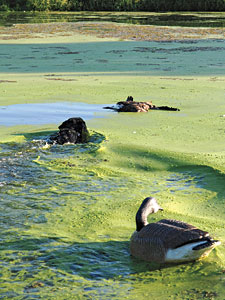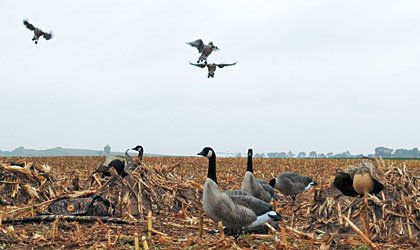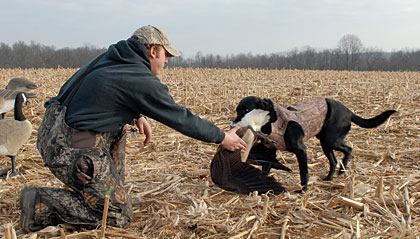"Shhh!" my hunting buddy J.R. whispered harshly. "I think I heard a honk." We both froze in our blinds and strained our ears to try to pick up some goose music. Within seconds, there it was--a faint ker-onk in the distance to our east.
By P.J. Reilly
J.R. and I heard the goose at the same time and instinctively dropped lower in our coffin layouts without saying a word to each other. Ben, on the other hand, got a terse "Down!" command from J.R. The black Lab obediently tucked his head back inside his own blind.
As the sound of honkers grew louder, J.R. and I began hammering away on our calls, doing our best to entice the still-unseen flying flock to our spread next to the small farm pond. Though it was only 7:30 a.m., it was already 80 steamy degrees on this early September 2009 morning. My partner and I had figured some local birds would seek shelter from the heat here sometime during this fifth morning of Pennsylvania's first goose-hunting season of the year.
A few weeks past his first birthday, Ben was enjoying his inaugural goose hunt. J.R. had spent months training him with dummies and live pigeons--but nothing truly prepares a young retriever for his first face-to-face encounter with a Canada goose. Dead or alive, it's an imposing bird, and we hoped Ben would rise to the challenge.
But whether Ben showed no fear as he approached his first downed Canada or he needed some encouragement, there was one thing J.R. and I knew for certain: Because we hunt in Pennsylvania--statistically, the best place on the continent to chase honkers--Ben was going to get a lot of practice working with the real thing.
Honker heaven
Pennsylvania sits smack in the heart of the Atlantic Flyway, the waterfowl migration route along the East Coast. With its ample, fertile farmland and plethora of creeks, rivers, lakes and ponds, it is nothing short of Shangri-La for Canada geese.
The state harbors three different populations of Canada geese during a typical year. There are the non-migratory resident birds that nest and live here all year long; the Southern
James Bay Population, which migrates south from Nunavut and Ontario each fall through the extreme northwestern corner of Pennsylvania; and the Atlantic Flyway Population, which migrates through the eastern half of the state, en route to and from Quebec and the Ungava Peninsula.
During the 2007-'08 and 2008-'09 hunting seasons, which were the two most recent seasons for which the U.S. Fish and Wildlife Service had data, Pennsylvania led all states and provinces in North America with its annual estimated Canada goose harvests. The 231,590 Canadas that Keystone State hunters bagged in 2008-'09 and the 276,047 birds they shot the previous year both led North America. The 2007-'08 season marked the first time ever that Pennsylvania earned the North American crown.
 A young Lab earns his stripes on Pennsylvania geese. |
"It had been Ontario for a while before that," said John Dunn, the Pennsylvania Game Commission's chief waterfowl biologist. "We've come a long way since the mid-1990s."
Indeed, few waterfowlers 15 years ago could have envisioned a day when Pennsylvania would be the most productive goose-hunting destination on the continent. In the mid-'90s, Pennsylvania goose hunting was going belly-up, thanks to a crash in the Atlantic Flyway Population of Canada geese.
All fall goose hunting across much of the state was closed for four years to take pressure off the birds, allowing them to rebuild their numbers. And to the delight of honker hunters, they did just that. As the geese became more plentiful, seasons and bag limits were expanded, new goose hunters joined the sport and the state's annual take exploded.
Much of the land my waterfowling club hunts in southeast Pennsylvania is tilled by Old Order Amish and Mennonite farmers, who tend their fields behind teams of large mules or Belgian draft horses. Technology advancements have led to the proliferation of computer-guided super tractors in many farming areas. Here in southeast Pennsylvania, however, the sight of large work horses plodding across fields, dragging rusty, noisy discs or single-row corn-pickers, has remained unchanged for the past century.
And while farms are bulldozed at an alarming rate elsewhere to make way for new homes and shopping malls, here in the land where time stands still, farming continues to thrive. That means it's a place geese can count on for succulent feasts year after year.
Working the Water
So this is the world Ben was introduced to following his birth at a kennel in New York, where the breeder caters to waterfowl hunters. His lineage suggested he should be a good hunter, and in training he showed great promise. On this muggy September morning, a group of five geese appeared over the trees at the edge of the farm we were hunting. It was game time.
 Three Canada geese descend on a decoy spread with hunters hiding in their blinds in a Pennsylvania cornfield. |
The birds worked our setup beautifully, gliding on cupped wings to a spot on the pond 25 yards in front of our blinds. As their black webbed feet reached out to touch the water, I gave the command.
"Take 'em!"
J.R. and I both sat up in our blinds, shouldered our shotguns and fired. One bird dropped stone-dead on the pond. Another took a direct hit but managed to sail over the water before crashing to earth amid several of our decoys at the pond's west end. Poor shooting allowed the three other geese to escape unscathed, but the stage was set for Ben--one retrieve by land and one by water.
Ben had been introduced to gunfire weeks before this first hunt, so he held fast in his blind while J.R. and I had our fun. When things quieted down, he poked his nose out of his blind and looked at J.R.
"Ben, fetch!" J.R. commanded.
Ben shot out of his blind like a rocket, made a few muscular bounds, then turned to look at J.R., as if to say, "Now what?"
J.R. pointed to the goose lying belly-up in the decoys on shore.
"Dead bird!"
Ben sprinted over to the goose and immediately began sniffing it.
"Fetch it up," J.R. urged.
Ben gingerly mouthed a wing, but quickly let go of it. J.R. walked over and told Ben to pick up the bird. Tail wagging, Ben darted around the goose, but he seemed intimidated.
"Try the one on the water," I called out.
J.R. approached the edge of the pond and ordered Ben to heel, and Ben obediently ran to J.R.'s right side and sat down. J.R. leaned over his dog's nose, pointed his hand toward the floating goose and repeated, "Fetch!"
 Everything clicked for Ben on Jan. 16, 2010, when he retrieved every goose asked of him. |
Without hesitation, Ben leaped into the pond and swam out to the goose, grabbing it by the body in his jaws. He turned around and swam right back to J.R.
"Good boy!" J.R. enthused as he took the goose and rubbed Ben's head and back.
With one successful retrieve down, J.R. and Ben headed back to the bird on shore, but still Ben wouldn't pick it up. It wasn't until J.R. grabbed the goose and threw it onto the pond that Ben readily swam out and returned it.
"I guess he's not ready for land retrieves yet," J.R. observed.
Through the end of that early-resident goose season and on into the first fall season aimed at the migratory flocks, Ben's performance in the field improved only slightly. He grabbed everything that hit the water, but he couldn't be counted on to bring back a goose that fell on land.
Back to the Field
The first fall season in southeast Pennsylvania is short, lasting only two weeks in mid-November. Ben hunted just twice in that span. It was the December-January leg of the season we were most eager for. That's typically when the most geese are around, there are plenty of holidays from work to afford time in the blinds and the season runs for more than a month straight.
A blizzard that started the first day of that late season and lasted for nearly three days, however, buried our hunting grounds under three feet of snow, dashing any plans we had for hunting geese in the near future. We didn't get out until mid-January. Ben hadn't hunted since late November, and J.R. worried the long layoff might have hurt his dog's hunting progress. Instead, Jan. 16, 2010, was the day it all came together for Ben.
Five of us trekked out to one of our favorite goose-hunting properties before daylight. With a three-bird-per-man limit during this part of the season, we'd be allowed to bag a total of 15 Canadas. We set up on the top of a hill, in the middle of a cornfield littered with partial and full ears of corn that had escaped the farmer's harvesting.
This was a straight field hunt, so there would be no water retrieves for Ben on this day. Scouting trips by J.R.'s dad to this farm during the few days before our hunt indicated a lot of geese were feeding in our field, so we felt certain we'd get some action. We wondered how Ben would fare.
It didn't take long to find out. Shortly after sunrise, flocks began crisscrossing the sky. Many seemed to have our field set as their destination. The geese were finicky, though; they didn't just dive into our spread of 130 Bigfoots.
We'd arranged the dekes to form a fishhook, figuring incoming flocks would follow the long leg of decoys into the curved formation in the spread where our blinds were positioned, then land in the open area right in front of our guns. That first flock of 20 geese or so looked us over good as they circled the field over and over.
Finally, the birds committed and hit the pocket as designed. The five of us came up firing, and birds dropped all over the place. Only when the shooting had stopped and everyone was given the order to put their guns on "safe" did J.R. call Ben out of his blind.
"Fetch!" he directed, pointing toward a trio of flopping geese about 20 yards out.
Ben saw the commotion the geese were making and darted directly toward them. He slammed into the first goose like a linebacker taking down a quarterback behind the line of scrimmage, snatched the bird in his jaws and loped back toward J.R. Even though Ben kept stepping on one of the goose's wings, jarring his head downward, he didn't let go of the bird until J.R. gave the command.
Ben heeled at J.R.'s side, and J.R. sent him off after the next goose. He picked that one up without hesitation, as he did the next. Apparently a light switch went off in Ben's head some time after his last hunt, because he performed like a champ that morning.
The sky was filled with geese all day, barely giving us any downtime. Some flocks circled and bailed out without ever offering a shot, but others read the script we'd written. We shot well, and Ben got all the work he could handle.
He chased down cripples and picked up dead birds with equal skill and confidence. It was as though he was a seasoned veteran. Sometime around 11 a.m., we bagged our 15th goose to fill our daily limit. Ben retrieved all but two, which one of the guys grabbed first.






